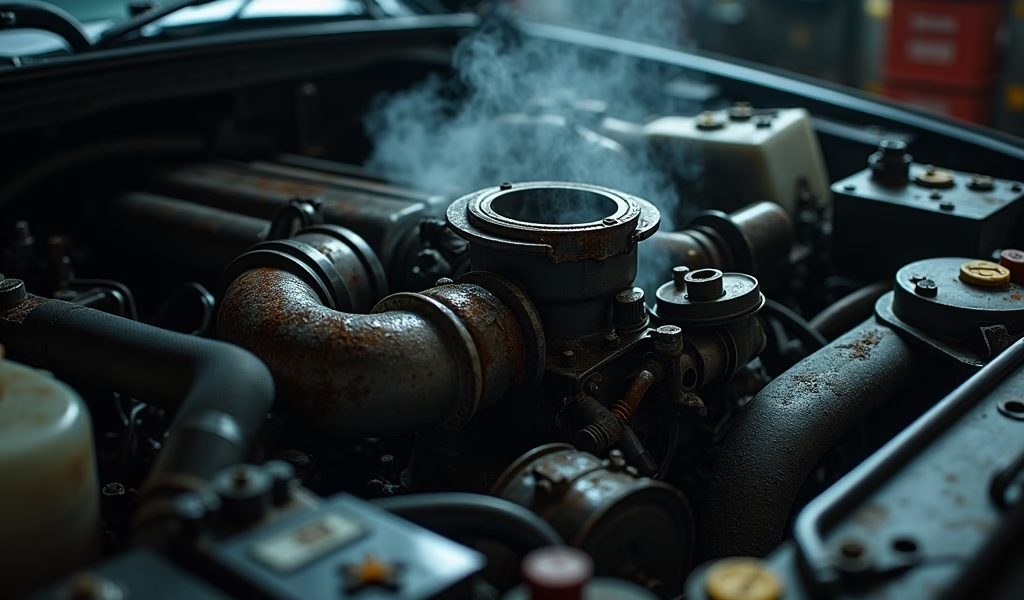Overview
This article explains how turbochargers work and offers five essential fixes for common turbocharger issues, including proper oil maintenance, addressing wastegate problems, removing carbon buildup, fixing boost leaks, and caring for the cooling system. For optimal turbocharger performance and longevity, the author emphasizes preventative maintenance like regular oil changes with synthetic oil, allowing proper cool-down periods, and keeping the cooling system in top condition.
Table of Contents
- Understanding the Turbocharger Magic
- How Turbochargers Actually Work
- Top 5 Turbocharger Fixes
- Conclusion
- Frequently Asked Questions
Understanding the Turbocharger Magic
Ever wondered how manufacturers squeeze so much power out of small engines? The secret lies in one of the most ingenious devices in the automotive world: the turbocharger. As someone who’s rebuilt countless turbos over my 20-year career as a mechanic, I can tell you these devices are like the hardworking magicians of your engine bay.
A turbocharger is essentially an air pump that increases your engine’s efficiency and power output by forcing more air into the combustion chambers. Think of it like a fan that helps stoke a fire – more oxygen means a more intense burn. The beauty of how a turbocharger works is that it uses exhaust gases that would otherwise be wasted to generate this extra power.
When Ford introduced their EcoBoost technology in vehicles like the F-150, they weren’t just following a trend – they were embracing a technology that delivers V8-like power from a V6 engine while improving fuel economy. That’s the real magic of turbocharging. Similarly, when you feel that satisfying surge of acceleration in a Honda Civic Type R or a Mercedes-AMG C43, you’re experiencing the turbocharger kicking in.
Today, nearly every manufacturer from Toyota to BMW uses turbocharging in their lineups. It’s not just about performance anymore – it’s about balancing power, efficiency, and meeting increasingly strict emissions regulations. The turbocharger has evolved from a performance add-on to a mainstream technology that helps create more efficient car engines in today’s vehicles.
How Turbochargers Actually Work
The Fundamental Components
Before diving into fixes, let’s understand what makes up a turbocharger. Think of a turbo as having three main sections working in harmony:
The turbine side is where exhaust gases enter and spin a wheel at incredibly high speeds – often exceeding 150,000 RPM in everyday passenger cars. Imagine a pinwheel in a hurricane; that’s essentially what’s happening inside your exhaust system.
The compressor side features another wheel connected to the turbine by a shaft. As the turbine spins, it drives the compressor wheel, which draws in fresh air and compresses it before sending it to your engine’s intake manifold.
The center housing contains precision bearings and oil passages that keep everything spinning smoothly. This section is the heart of the turbo, requiring perfect lubrication to prevent premature failure.
Additional components include the wastegate (which regulates boost pressure), the blow-off valve (which releases pressure when you lift off the throttle), and often an intercooler (which cools the compressed air for better efficiency).
The Boost Cycle Explained

The turbocharging process is a beautiful example of energy recycling. Here’s how it happens in a cycle that takes milliseconds to complete:
When you press the accelerator, your engine produces exhaust gases that flow through the exhaust manifold and into the turbocharger’s turbine housing. These hot, fast-moving gases spin the turbine wheel, much like wind turns a windmill.
As the turbine spins, it drives the compressor wheel on the other end of the shared shaft. This compressor wheel pulls in ambient air, compresses it (increasing its density and oxygen content), and forces it into the engine’s intake system.
This compressed air then passes through an intercooler in most systems, which works like a radiator to cool the air. Why cool it? Because cooler air is denser and contains more oxygen molecules per volume, allowing for better combustion.
The pressurized, oxygen-rich air enters the cylinders where it mixes with fuel and creates a more powerful explosion than would be possible with normal atmospheric pressure. This is why a turbocharged 2.0-liter engine might produce power similar to a naturally aspirated 3.0-liter engine.
The difference between turbocharging in petrol and diesel engines is notable – diesels often benefit even more from turbocharging due to their higher compression ratios and combustion characteristics. That’s why almost all modern diesel engines come turbocharged from the factory.
This whole process creates what drivers feel as “boost” – that satisfying surge of power that pushes you back in your seat when the turbo spools up. It’s also why turbocharged engines sometimes exhibit what’s called “turbo lag” – the brief delay between pressing the accelerator and feeling the full power as the turbo gets up to speed.
Top 5 Turbocharger Fixes
Fix #1: Proper Oil Maintenance
If turbos had a kryptonite, it would be poor oil quality or flow. With turbine speeds that can exceed the redline of a Formula 1 engine, proper lubrication isn’t just important – it’s critical. I’ve seen more turbos destroyed by oil issues than all other causes combined.
The most essential maintenance for any turbocharged vehicle is frequent oil changes using the manufacturer-specified synthetic oil. For heavily driven turbo cars like a hard-worked Toyota Supra or a Ford F-150 that tows regularly, consider changing oil every 5,000 miles instead of stretching to the maximum interval.
Another oil-related issue stems from how you shut down your engine. After hard driving, allow your car to idle for 30-60 seconds before turning it off. This simple habit allows the turbo to cool down gradually while maintaining oil circulation, preventing the oil from “coking” (baking into a hard carbon deposit) in the turbo’s oil passages.
Common signs of oil-related turbo problems include:
- Blue smoke from the exhaust (oil leaking past worn turbo seals)
- Decreasing boost pressure over time
- Loud whining or whistling noises
- Oil leaks around the turbocharger
The fix often involves replacing worn oil feed or return lines, ensuring they’re free from kinks or restrictions. In more severe cases, the turbo’s center housing rotating assembly (CHRA) may need rebuilding or replacement. A quality CHRA rebuild typically costs $300-700 in parts and labor – much cheaper than a complete turbo replacement that might run $1,000-2,500 depending on the vehicle.
For preventative maintenance, consider installing an oil catch can on modified turbo cars. This simple device helps capture oil vapors from the crankcase ventilation system before they can contaminate your intake tract and intercooler system.
Fix #2: Addressing Wastegate Issues
The wastegate is your turbocharger’s pressure relief valve. When it works properly, it prevents excessive boost that could damage your engine. When it fails, you’ll either experience underwhelming performance or potentially dangerous overboost conditions.
Many factory wastegates are actuated by a small canister with a spring-loaded diaphragm that opens a valve when boost reaches a predetermined level. Over time, these components can wear out, leading to inconsistent boost control.
Symptoms of wastegate problems include:
- Inconsistent boost pressure
- Check engine light with codes related to boost control
- Rattling noise from the turbo area
- Either significantly lower or higher boost than specified
To diagnose wastegate issues, you’ll need a boost gauge or scan tool that can read real-time boost pressure. Compare what you’re seeing to factory specifications. If you have an aftermarket boost controller, make sure it’s properly calibrated.
For external wastegates (common in performance applications), adjustment is relatively straightforward. The actuator rod length can be adjusted to change the point at which the wastegate opens. For internal wastegates (more common in factory setups), you may need to check the electronic solenoid that controls the actuator.
In many modern vehicles like those from the Mercedes-AMG lineup, wastegates are electronically controlled with sophisticated mapping. These systems require dealer-level diagnostic equipment to properly troubleshoot. However, if you’re experiencing wastegate issues on an older or simpler turbo system, the actuator can often be rebuilt or replaced as a DIY job for around $100-200.
Fix #3: Tackling Carbon Buildup
Carbon buildup is the silent performance killer, particularly in direct-injection turbocharged engines. Unlike port injection where fuel helps clean intake valves as it passes over them, direct injection sprays fuel directly into the combustion chamber, leaving intake components vulnerable to carbon accumulation.
This carbon buildup restricts airflow, forces your turbo to work harder than necessary, and can eventually lead to misfires and significantly reduced performance. I’ve seen vehicles regain 20-30 horsepower after a thorough carbon cleaning!
Signs of carbon buildup include:
- Rough idle and hesitation when accelerating
- Reduced power and throttle response
- Poor fuel economy
- Misfires, especially at lower RPMs
- Check engine light with misfire codes
For mild carbon buildup, chemical cleaners can help. Products that are introduced through the intake or added to the fuel tank can reduce carbon deposits, though they rarely solve severe cases. For a comprehensive cleaning, there are three main approaches:
Walnut blasting has become the gold standard for intake valve cleaning. This process involves removing the intake manifold and carefully blasting walnut shell media at the intake valves to remove carbon deposits without damaging metal surfaces. It’s messy but extremely effective.
Chemical cleaning with specialized tools that introduce strong solvents directly to the intake valves can be less invasive than walnut blasting but may not be as thorough for severe cases.
For turbocharged direct injection engines like those found in many Ford, Honda, and Toyota models, consider a carbon cleaning service every 30,000-60,000 miles, depending on driving habits. The service typically costs $300-700 but can save thousands in potential damage and lost efficiency.
To prevent excessive carbon buildup, occasionally drive your turbocharged vehicle at higher RPMs (safely and legally, of course). This “Italian tune-up” helps clean out deposits through higher exhaust temperatures. Also, using top-tier fuels with better detergent packages can help minimize carbon formation.
Fix #4: Fixing Boost Leaks

Boost leaks are the bane of turbocharged engines. They’re like trying to fill a balloon that has tiny holes – no matter how hard the compressor works, full pressure can’t be maintained. These leaks can occur anywhere in the pressurized side of your intake system, from the turbo compressor outlet to the intake valves.
Common boost leak locations include:
- Intercooler hose connections
- Blow-off valve or diverter valve seals
- Wastegate seating surfaces
- Intake manifold gaskets
- Cracked plastic intake components (common on older turbocharged vehicles)
The symptoms of boost leaks are often subtle at first: slightly reduced power, a faint hissing noise under acceleration, or inconsistent boost readings. As leaks worsen, you’ll notice more dramatic power loss and potentially hear more obvious sounds of escaping air.
Finding boost leaks can be done with a few different methods. Professional smoke machines allow you to pressurize the system with visible smoke that will escape from any leaks. For DIY mechanics, a homemade pressure tester can be created using a spare intercooler pipe, pressure gauge, and air compressor fitting.
The simplest test involves spraying soapy water around suspected leak areas while the engine is running under boost – bubbles will form at leak points.
Fixing boost leaks typically involves:
Replacing damaged silicone hoses and ensuring clamps are properly tightened. T-bolt clamps offer better sealing than worm-gear clamps for high-boost applications.
Inspecting and replacing gaskets, particularly around the throttle body and intake manifold. Troubleshooting these engine components often reveals overlooked issues.
Checking for proper operation of the blow-off valve or diverter valve – a stuck or leaking valve can cause significant boost problems.
For more serious leaks involving cracked components, replacement with OEM or high-quality aftermarket parts is necessary. Avoid temporary fixes like epoxy on pressurized components – they rarely last and can lead to bigger problems.
After making repairs, conduct a pressure test to ensure the system holds pressure before hitting the road. This extra step can save you from the frustration of continuing leaks.
Fix #5: Cooling System Care
Turbos generate enormous heat – the turbine side can reach temperatures over 1,800°F in extreme conditions. Proper cooling is essential not just for the turbo itself but for the compressed air it produces. Remember, cooler air is denser air, which means more power.
The cooling system for a turbocharged engine has two critical components: the engine coolant system (which indirectly helps cool the turbo) and the charge air cooling system (intercooler).
Signs of cooling system issues include:
- Heat soak (power loss after sustained hard driving)
- Engine running hotter than normal
- White smoke from the exhaust (in severe cases)
- Intercooler piping hot to the touch after driving
Maintaining your cooling system starts with regular coolant changes using the manufacturer’s recommended coolant type and mixture. For turbocharged vehicles, this is especially important as the coolant helps regulate oil temperatures, which directly affects turbo longevity.
For the intercooler system, regular inspection is key:
Check for debris blocking airflow through the intercooler core. Road grime, leaves, and insects can significantly reduce cooling efficiency. A gentle cleaning with low-pressure water (never high-pressure when the engine is hot) can restore proper airflow.
Inspect intercooler hoses for collapse under vacuum or bulging under pressure – both indicate weakening that could lead to failure.
Consider upgrading to a larger intercooler for heavily modified turbocharged engines or vehicles used in hot climates. The stock intercooler in many vehicles like the Toyota Camry TRD or Ford Focus ST is adequate for factory power levels but may become a restriction when more boost is added.
For vehicles used in extreme conditions, like a turbocharged Mercedes G-Class taken off-road in hot weather, additional cooling modifications might be necessary. Aftermarket oil coolers can help manage oil temperatures, indirectly benefiting turbo health.
Remember that proper warm-up and cool-down periods are part of your cooling system care. Allow your engine to warm up properly before hard driving, and give it a minute of idle time after hard runs to help stabilize temperatures before shutdown.
Conclusion
Understanding how a turbocharger works isn’t just for gearheads – it’s practical knowledge for anyone driving a modern vehicle. With more manufacturers adopting this technology across their lineups, chances are your next vehicle will feature a turbo if your current one doesn’t already.
The beauty of turbocharging lies in its elegant efficiency: capturing wasted energy from exhaust gases and converting it to usable power. When properly maintained, a turbocharger can provide thousands of miles of trouble-free service while delivering that addictive boost we’ve come to love.
Remember that prevention is always better than cure. Regular oil changes with high-quality synthetic oil, allowing proper cool-down periods after hard driving, addressing minor issues before they become major ones, and keeping your cooling system in top shape will go a long way toward turbo longevity.
Whether you’re driving a workhorse Ford F-150 with EcoBoost technology or enjoying the spirited performance of a Honda Civic Type R, your turbocharger deserves attention and care. It’s not just another component – it’s the heart of your vehicle’s performance character.
Have you experienced any turbo-related issues with your vehicle? Do you have questions about upgrading or maintaining your turbocharged engine? Drop a comment below and let’s keep the conversation going. Your experiences might just help another reader avoid costly repairs down the road.
Frequently Asked Questions
How long should a turbocharger last?
With proper maintenance, a turbocharger should last 100,000-150,000 miles. Regular oil changes and allowing proper cool-down after hard driving are the most important factors for longevity.
Does a turbocharger work all the time?
No, a turbocharger only provides boost when the engine is under load and producing sufficient exhaust flow. At idle or light cruising, the turbo spins but generates minimal or no boost.
Can I drive a car with a bad turbocharger?
You can drive with a failing turbo, but you’ll experience reduced power and potentially engine damage if the issue involves oil leaks or debris. It’s best to address turbo problems promptly.
Do turbocharged cars require premium fuel?
Many turbocharged cars are designed to run on regular fuel, but premium fuel often provides better performance. Always follow the manufacturer’s recommendation in your owner’s manual.
What causes turbo lag?
Turbo lag is caused by the time it takes for exhaust gases to spin the turbine up to speed after throttle input. Factors affecting lag include turbo size, exhaust system design, and engine RPM.

